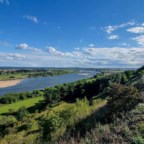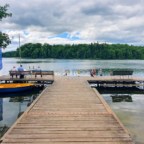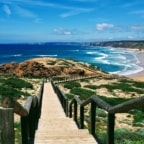At the end of our tour of the Canary Islands, we left ourselves smaller than Tenerife and Fuerteventura, the easternmost Lanzarote. A destination very popular among the offers of travel agencies, and somehow we were not drawn there…. Until now! A small, modest, austere island, what can be done there?
It turns out that quite a lot, and the island very positively surprised us with the climate, terrain, beaches and…. all the rest!
This volcanic island is home to slightly more than 140,000 people. You won’t think much of it, but the towns give the impression of being crowded, with traffic on the streets like you don’t know what. OK, we were in high season (Christmas), and from what we have read, it is during such periods that the population on the island doubles :)
Table of contents
Travel by ferry between Fuerteventura and Lanzarote
There is, of course, an airport in Lanzarote, so you can fly between the islands with, among others, the excellent Binter Air airline, which we have written about more than once. This time, however, we took the sea route from Fuerteventura. Ferries run several times a day between Fuerteventura and Lanzarote. So no matter which island of the above you decide to spend your vacation on, you can easily cross over to a neighboring island for a day.
The trip itself is very short, about 45 minutes. You can cruise with a car as well as a walking version ;)
We recommend you book your ticket in advance (online), even more so if you will be in peak season. It is not required, but sometimes there are not enough seats for a particular hour and you have to wait for the next course. Besides, by buying early you can save a little :)
We took the ferry to Playa Blanca and here we were booked for the next shortest stay. This time we were in a typical tourist resort, with cottages. We had at our disposal a well-equipped apartment with a kitchen and a terrace. But of course, being in Lanzarote for two days, it would be a shame to spend them in a hotel, so we decided to hit the road right away.
Little Great Lanzarote
Below we describe the most important places we saw during the entire two days.
In general, we were very surprised that there is so much to see here. We simply did not expect that such a small island could offer us as much as the larger Tenerife or even Fuerteventura. And we were wrong, and wrong a lot. Lanzarote made a very big and positive impression on us. The landscapes are beautiful and varied, and when spending a vacation on this island, we don’t have to limit ourselves to just beachcombing.
It’s just a shame that a lot of the attractions come with a fee. Interestingly, there are special combination tickets for various attractions, which we recommend getting if you know what you want to see and where to enter. You can easily save a lot of euros by buying tickets to several places in advance.
At the outset, it should still be mentioned that César Manrique, a local artist who designed, among other things, the appearance of Lanzarote, was very influential. Mirador del Rio, Jardin de Cactus or the concert hall at Jameos del Agua. While in Lanzarote you will surely encounter this name more than once :)
Jameos del Agua
This is one of the biggest attractions on the island – the most distinctive site here is a cave with a water reservoir, which was formed in a volcanic tunnel as a result of an eruption of the volcano de la Corona. The tunnel itself at Jameos del Agua is one of the longest volcanic tunnels in the world, and the biggest phenomenon is actually a reservoir filled with seawater. It is inhabited by “jameitos,” white blind crabs that are up to 1 cm long and have become almost a symbol of the place.
The cave itself is not long (60 meters), a boardwalk has been prepared along which you walk to the arranged pool. The grotto also has an auditorium for 500 people with surprisingly good acoustics.
The whole place is very interestingly arranged, and there is also a restaurant, so you can have lunch in a unique place.
Cueva de los Verdes
Not far from Jameos del Agua, there is the Cave de los Verdes, which is also part of a volcanic tunnel after the eruption of the aforementioned volcano de la Corona. The tunnel was created when the flowing lava solidified from the top, while hot lava continued to flow underneath, forming various rock formations.
The passage through the cave is done only with a guide, in a group. It tells the history of the place and points out unique formations that we probably wouldn’t have noticed on our own. The walk is quite long and you often have to bend down, as the cave is very low in places. The biggest attraction is the “mini-show” done by the guides inside the cave, but we won’t reveal what it’s about so as not to spoil your surprise ;-)
According to us, the cave is number 1 in Lanzarote:)
Mirador del Rio
Already quite familiar with the Canary Islands, we were used to the ubiquitous “miradors,” or viewpoints. Always free! What was our surprise when we were asked to pay an entrance fee at Mirador del Rio….
Is it worth paying for such a view? Well… you can stand on the road next to it and have a very similar view…. albeit you pay not only for the view, but also for admission to the complex also created by César Manrique in 1974. Mirador dle Rio is an elevated vantage point (475 meters) with a special platform and restaurant, offering views of the nearby island of Isla Graciosa.
You can have admission as part of a combined ticket to many attractions, so then it’s even cheaper. Is it worth it? Judge for yourself by the photos ;)
Salinas
Lanzarote is also famous for its salinas – places where rock salt is extracted by evaporating water from brines. The village of Janubio in the southwest is home to the largest salinas in the Canary Islands (440,000 m2 of surface area!).
Their construction began in the late 19th century to obtain salt for preserving fish. The colorful palette is a very interesting addition to the local landscape. Of course, there is a viewpoint of the salinas nearby.
Los Hervideros
Driving toward El Golfo from the salinas in Janubio, we pass the rocky coast of Los Hervideros on the way. This is a major attraction in the area, as indicated at least by the parking lot full of cars. Here we can admire the wonders created by the lava in the form of numerous caves, isthmuses, rifts or crevices.
The view is all the more interesting because every now and then strong waves hit the shore and poured into all these formations. We hit really high waves :).
Charco de los Clicos/El Golfo
El Golfo is the name of the village and the volcano, the latter of which is now partially underwater. For this, on land, we can admire one of the effects of its activities – Lake Charco de los Clicos. It is a bit of a cosmic sight – an angry green lake right at the foot of the rocks.
The lake owes its color to the algae that grow in it. Interestingly, the lake is diminishing quite dramatically – in the last twenty years, its area has halved! Just so you know…. let’s hasten to love….
Of course, with our luck, renovations were just taking place here and access was only possible from one side, with heavy equipment spread around. Going down was impossible.
Montanas del Fuego and Parque Nacional de Timanfaya
Park Nacional de Timanfaya is located in the western part of the island. This is the area where one of the largest volcanic eruptions in the world took place. It began on the 1st. September 1730 and lasted six years, destroying 50 villages. Looking at satellite images, one gets the impression that the site was targeted by asteroids that left tiny craters in the ground.
Otherwise, the area is known as Montanas del Fuego, or Mountains of Fire.
There is a fee to enter the park. After a short ride, you reach the information center, where you transfer to buses that tour the park. We probably don’t need to mention that the place is designed by César Manrique ? ;) Passage by private car is prohibited!
The route is called Ruta de los Volcanos and is some 14 kilometers long. The road is scenic, leading among numerous craters and rock formations. Everything is admired from behind the windows of the bus – it doesn’t stop anywhere to go out to take pictures. The attraction in itself is the ride itself and admiring the skill of the driver, who maneuvers the rather sizable vehicle along narrow paths over steep slopes.
At the end of the tour, a short show is prepared for tourists showing how active and hot the ground is – you can watch explosions, shooting water and other attractions.
Oh, important – quite passionately tourists are looking for local insects, so expect that the windows of your car will even be covered with them ;)
Jardin de Cactus
Near the village of Guatiza there is a garden with cacti – you will know this place by the big cactus by the roadside :)
There is a fee for the garden (5 eur), and it takes 30min – 1h to visit depending on your interests. There are more than 1,000 different types of cacti in the garden, and a windmill reigns supreme, offering views of the immediate area.
Of course, the site was designed by…? ;)
Lanzarote? Recommended!
All in all, the island really surprised us positively :)
There are a lot of attractions here, and you can spread them out quietly over several days. These are primarily places shaped by nature, not any historical monuments. In addition, it is all nicely organized – attractions are prepared to the same standard, you can get tickets for many attractions, which comes out favorably priced.
It can be seen that all attractions are managed top-down, rather than each place organizing work for itself, which makes it much easier for tourists to visit.
Of course, this is a typically touristy island, in high season it’s hard with reservations and expensive at every turn, but it’s still worth sailing/flying to Lanzarote if only to see how different this island is from others.
You can find all the points on the map below:
Last but not least, of course, we still recommend our gallery:















































